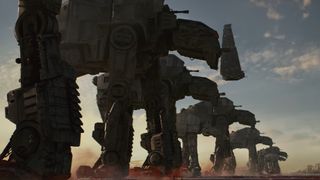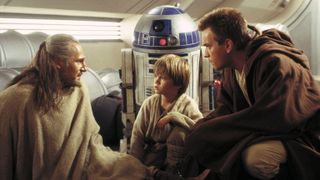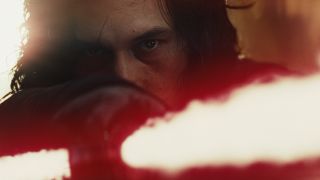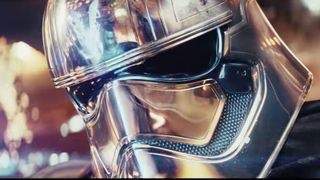For me, The Last Jedi is the best of the Star Wars movies. Far from perfect, a little too long, and not without its overly-saccharine moments, it delivers all the things a Star Wars movie should in 2017. While not exclusively a product of its time and place, however, The Last Jedi taps deliberately into its past to create many of its moments that feel like ‘pure Star Wars’. And it’s very apparent that the prequels - often maligned for not being up to the same standard as the original trilogy - had some of the biggest influences on The Last Jedi. Crucially, though, this latest movie does these things right.
The prequels are often lambasted for being both overly goofy and overly melodramatic, leaving them a bit of a middling mess with a confusion of character motivations, plot points, and tones. In attempting to tell an origin story that appeals to a new, younger generation of Star Wars audience - while not upsetting the hardcore fans - George Lucas simply didn’t have the subtlety of storytelling to dramatically please either group. And when he attempted to overtly politicise Star Wars via trade disputes, greed, and the notions of political arrogance… it all fell very flat. However, that’s exactly what Star Wars needs to do, it’s just that Lucas’ execution of those ideas was inadequate, as Dave Houghton discusses at length in his excellent breakdown of why the prequels were almost brilliant.

Warning: some spoilers for Star Wars: The Last Jedi follow.
Rian Johnson recognised that the Star Wars prequels had the right idea, and they technically ticked all the boxes to feel thoroughly modern, which is why we see so many echoes of them in The Last Jedi. Let’s start with the most obvious example, which is the theme of ‘balance in the Force’ - a not-so-subtle metaphor for equality, tolerance, and moderation of opinion in the modern world. The prequels desperately attempted to tell a story that explained what the Force actually is, and why it was so important that Anakin didn’t just become an all-powerful Light Side Jedi, but instead brought balance to the Force instead. While it had some neat ideas, like overtly showing the arrogance of the Jedi Council, it mostly muddied the issue by bumbling about Midi-chlorians, and having Anakin become comically evil instead of gradually giving in to his emotions and falling to the Dark Side. For a story that uses the word ‘conflict’ so much, we see precious little of it in young Vader.
The Last Jedi channels all these ideas through its two central characters - Kylo Ren and Rey - who exist in sharp contrast to the movie’s exemplars of Light (Luke) and Dark (Snoke). While Lucas always treated Star Wars as the pure conflict between good and evil, which he’d created with the original trilogy, Rian Johnson uses these polar opposites to tell the real story of the Force, which happens in the middle. In the grey areas. The prequels talked with great importance about balance, but never suggested what that might be. In Last Jedi we see that Kylo Ren and Rey are actually philosophically similar, something that becomes apparent through their Force connection… it’s just that their methods for bringing balance differ. Both are keen to usher in a new, moderate version of the ‘Jedi’, but while Kylo Ren wants to forcefully erase both the arrogance and the evil of the past, Rey is more concerned with embracing it and bringing understanding rather than dictatorship. Their end-goals, however, are basically the same.
A place and time

This all ties in with another strong theme from the prequels, which is the one about individuals finding their place in the world / galaxy. Lucas tried to tell the story of a lowly orphan on Tatooine, who discovered he was special and tried to fulfil his own destiny. Similarly, he attempted to contrast Anakin’s journey with that of Padme, a princess thrown into the reality of conflict and asked to grow up ahead of her time because of the weight of expectation on her shoulders. There’s no masking the fact these themes in the prequels mirrored the hardships of finding your own place and identity in the modern world, and the dangers of what happens if you’re untrue to yourself. There are so many influences on us, and conflicting opinions, which leads to either confusion or a closing off from reasoned and rational arguments, because we can’t cope with the uncertainty. But again, Lucas lacked the subtle hand to sheer the Star Wars behemoth in a satisfying way, and both Anakin and Padme became caricatures forged by the ridiculousness of their environment, and we lost any real sense of connection we might have had with them. We failed to share their journey after about the end of The Phantom Menace.
The Last Jedi deals with similar issues, but comes at it from a slightly different angle. Rey is the lowly girl, who just wants to find her place in the universe, while Kylo Ren is the one feeling the weight of expectation. Instead of being purely reactive, however, and acting in a very black and white way, we see the pair trying to come to terms with their conflicted feelings. Not only that, we see them relating to each other while doing it. What makes it work is that we see both of them surrender to impulses - as we all do - without becoming paragons of good or evil. We never saw the actual conflict within Anakin as he became Vader: we saw his anger and his appalling deeds. With Kylo Ren we actually see him struggle to come to terms with complex emotions around expectation, failure, fury, and loss. Similarly, with Rey, we don’t have a noble Jedi who goes her own way and triumphs. We see her fail to deal with Kylo Ren, to barely take note of Luke’s teachings (despite telling him she won’t be like Ben Solo), and to eventually realise that there is more to power than the positive or negative extremes of it.
In the context of today’s political climate, this is exactly how Star Wars should be representing itself. Regardless of your views, the notion of seeing something as purely good or evil, right or wrong, isn’t a useful stance to take in the modern world. There should absolutely be personal conflict in between these extremes, and while the prequels attempted to show that, it’s only now with The Last Jedi that Star Wars has been mature enough to tackle the issue.
The prequels also attempted to highlight the dangers of corporate greed, via the introduction of the trade dispute and the blockade in The Phantom Menace, but failed to really explore the reasons behind it, instead presenting it as a black and white ‘bad’ plot point used to spark the conflict that raged throughout the whole prequel trilogy. A few minutes of smooth talking with The Last Jedi’s master hacker DJ (Benicio Del Toro), and a handful of not-so-subtle shots of Canto Bight does a far better job of highlighting the complexities of corporate culture, greed, and the widening gap between rich and poor than the three whole prequel movies combined. Actually, while we’re on the subject of Canto Bight… it’s not like the Last Jedi is superior in every way. I’d actually argue that the Podracing sequences of Phantom Menace - clearly reflected in the kinda-horse-racing on Canto Bight - are superior to the race and chase moments in Rian Johnson’s movie.
Funny because it's true...
And there are loads more overt touches from the prequels that Johnson remastered and added to The Last Jedi. He took their playful sense of humour and added some genuine laugh out loud moments to this movie, but never tried too hard for laughs. Part of the reason Jar Jar, the comedy relief of the prequels, is so hated is because he’s horrifically out of step with the tone of those original movies. It’s as if someone said ‘Hey, George, these movies are a bit dark, mate. You need something to lighten the tone,’ and instead of inserting clever laughs he opted for the ‘class clown’ approach. In The Last Jedi, the jokes are more in line with Rogue One’s knowing, self-reflective wit, and the ridiculousness of the alien worlds in which the events happen. Come on! There are literal fishwives on Ahch-To!

Finally, there’s the marketability of the movie. The prequels were created with an intent to cash in on the Star Wars brand, and sell not only the film itself, but also a multitude of creatures and characters that could be turned into cuddly-toys and TV spin-offs. But the prequels were way too overt with their attempts and, again, I’m going to have to pick on Jar Jar. While envisioned as a wise-cracking sidekick ripe for spin-offs and plushies, he became a focus of hate because he tried too hard to be marketable. With the latest trilogy, and especially The Last Jedi, the more commercially appealing aspects are either cool or cute, without being overdone. Let’s be clear, though, The Last Jedi (and The Force Awakens) are cash cows as much as creative endeavors. BB-8 is a toy-maker’s dream, while the Porgs are cute and just sparingly enough used to be fluffy assets this Christmas, rather than agitations.
Perhaps, if I’m being fair, viewers are more accustomed to reading the subtleties in movies and TV in 2017 than they were back in 1999, which made Rian Johnson’s job a little easier. Either way, for all the wonderful, brand new things The Last Jedi does, there’s no doubt it owes a debt to the imperfectly formed ideas from the prequel trilogy. The movie is respectful of the past, while firmly focused on the present and the future of all things Star Wars, and simply wouldn’t have been as powerful had it ignored this controversial part of the franchise’s past… Okie-day?



